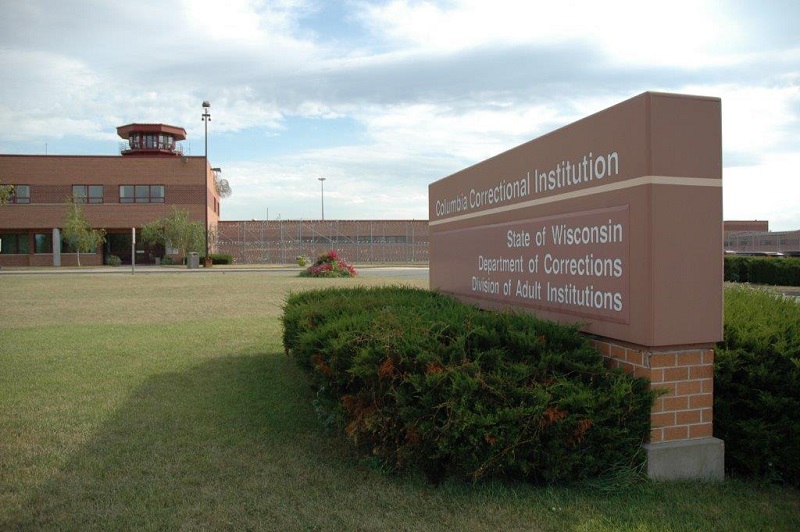Columbia Prison at 153% of Capacity
Inmates sleep on the floor because there are not enough beds. Part 4 in a series.
Inmates at Columbia Correctional Institution sleep on the floor because there are not enough beds, according to a Department of Corrections budget request.
Others are released from prison directly from a solitary confinement unit where they “are single celled, have no movement, eat in cell, recreate alone or segregated, and have very limited property.”
The released inmates “not only haven’t functioned in society in some time, but they haven’t functioned in general population of the institution in some time, if ever,” DOC said in its request for $25,354,000.
The State Legislature and Gov. Scott Walker said no and established a study committee to discuss the state’s prison needs.
This is part 4 in our series on Wisconsin prisons, how crowded they are, and what the Department of Corrections said is needed to improve, repair, and maintain them.
Here is Part 1, Part 2, and Part 3.
And here is a link to a video of State Rep. Evan Goyke‘s presentation, titled “Inmate 501: Converging Problems in Wisconsin’s Prison System,” on the choices for Wisconsin’s prison future. As he says in his accompanying publication, “Inmate 501 will be the first Wisconsin inmate sent out of state because of overcrowding in nearly 20 years. Recent prison population growth is set to exceed all available options in state. We face challenging decisions. Do we send people out of state? Do we build a new prison? Do we reform?”
Goyke votes for reform. So do we.
This primer does not really address the consequences of the crowding and physical shortcomings of the institutions – the impacts on inmates and staff. But we sure hope you will keep them in mind as you consider the price of mass incarceration.
Institution: Columbia Correctional Institution, Portage
Classification: Maximum security
Capital budget request: $25,354,000
Status: Rejected
From the request: This project would construct a new 100-cell Transitional Housing Unit next to the current housing Unit 9 building for inmates with special program needs, including inmates needing to integrate back into general population after long periods in segregation. …
The Transitional Housing Unit will be ADA compliant and able to accommodate inmates with special physical needs, such as being confined to a wheelchair. It would be preferable that at least 50% of the cells are on ground level, and would not require the use of a lift. At a minimum, in order for CCI to be ADA compliant, 16% of the cells must be built on ground level.
The Transitional Housing Unit will have single and double cells (approximately 20% of the total cells will be double cells). It will also have programming space for group and individual programming, a dayroom for eating meals and for recreation, a food servery for preparing meal trays, an officer’s control bubble, an officer’s workstation in the dayroom, storage space for supplies/equipment, storage space to house medications, a unit laundry for inmate clothing, and office space for staff such as clinicians, social workers, and housing unit management staff.
Expansion to the RH2 building will include program/treatment areas, staff offices, no-contact visiting space, and storage. In addition, the recreation pens will be covered to allow for outdoor recreation in all seasons.
The RH2 currently does not have any programming space, or adequate treatment space. Inmates are evaluated by health services staff and psychological services staff in the dayroom providing for no means of confidentiality. There is inadequate storage space requiring supplies to be stored in the open of the dayroom. There is no office space for staff in RH2, and staff currently uses limited office space in other buildings in the institution.
The new Transitional Housing Unit will be built to allow for flexibility in programming to meet the needs of the dynamic inmate population at CCI. This includes inmates needing to integrate back into general population after long stays in restrictive housing (greater than 120 days), inmates prone to self-harm, and inmates that struggle to function in general population. This might include inmates with temporary physical limitations (possibly after surgery), inmates with serious mental health issues, or inmates with gender identity disorders.
This type of flexibility in a housing unit is a critical need at CCI for the following reasons:
- Transitional Step Down – Currently, CCI has a Restrictive Housing Unit 1 (RH1) and a Restrictive Housing Unit 2 (RH2). Inmates typically transition from RH1 to RH2 before going back to general population. Inmates in RH1 are single celled, have no movement, eat in cell, recreate alone or segregated, and have very limited property. Inmates in RH2 are typically double or triple celled (with the third inmate sleeping on the floor with a mattress), have very limited movement with escort, eat in cell, recreate alone or segregated, and have additional property, but still far less than general population.
The new Transitional Housing Unit will be an additional step between RH2 and general population that will allow the inmate to still be in a restrictive status, yet live as they would in general population. Inmates will have an opportunity to have a roommate, eat in the dayroom with others, recreate in the dayroom with others, order all available canteen, have more property, and possibly have more movement. It will allow the inmate to reintegrate into the general population lifestyle, while allowing staff to monitor the inmate in a more controlled environment than general population.
Inmates are evaluated by health services staff and psychological services staff in the dayroom providing for no means of confidentiality.
- Restrictive Housing Release – There are currently inmates that, due to mandatory release dates, are releasing back into society from RH1. These inmates not only haven’t functioned in society in some time, but they haven’t functioned in general population of the institution in some time, if ever. With the new unit, these inmates will be moved to the transitional unit several months before release so they can begin to reintegrate and function outside of the restrictions in restrictive housing. This will allow inmates a better opportunity to receive needed programming before release, and a better chance at re-entry.
- Observation – Currently inmates having thoughts of, or exhibiting acts, of self-harm are placed in a controlled or observation status in RH1. They are given no property or very limited property. Some of these placements are a result of legitimate self-harm situations, and some are inmates manipulating the system.
Inmates who are genuinely struggling in general population are placed in control or observation on a restrictive housing unit, although they are not in a disciplinary status. The environment in RH1 can be very loud and disruptive and not conducive to overcoming thoughts or behaviors of self-harm. A wing on this new transitional unit would be dedicated for observing inmates needing a controlled environment away from general population, and out of a restrictive unit.
Inmates who are manipulating the system may feign thoughts of self-harm to avoid situations in general population, such as conflicts with other inmates, or conduct reports/sanctions. Still others feign thoughts of self-harm because they are aware of CCI’s bed constraints, and know a fellow inmate may be released from RH1 if observation beds are full. Inmates suspected of feigning thoughts of self-harm to get fellow inmates out of RH1 would no longer have that motivation, as the number of observation beds available would not be dependent on the number of segregation beds filled. …
The environment in RH1 can be very loud and disruptive and not conducive to overcoming thoughts or behaviors of self-harm.
- Institution Bed Management – Since the expectation is that some inmates currently living in general population housing units and RH2 will move into the new transitional unit, more bed space will become available in the existing housing units. This will allow for better bed management of the other general population and restrictive housing units at CCI.
Inmates are often forced to sleep on the floor because bunk space is not available due to the “do not double” (DND) requirements of other inmates. This is most prevalent in RH2. Bed space is also limited because of the sheer number of inmates needing certain programming, and therefore needing placement on a particular unit. As of July 18, 2016, 15 inmates were without a bunk and sleeping on the floor. All of those inmates were in RH2. With the new transitional unit, it would be expected that CCI would have sufficient bed space and no inmates would need to sleep on the floor.
CCI also often makes decisions to release inmates from RH1 to RH2, and from RH2 to general population, based on the lack of bed space in the restrictive housing units. Having the new transitional unit step down unit will provide the additional restrictive housing unit beds needed to allow staff to make decisions for restrictive housing placement based on the inmate’s needs and institution security, not based on bed availability.
- Restrictive Housing Unit 2 does not offer any space for inmates to obtain programming or treatment on the unit. Providing programming to these inmates while in RH2 will allow for shorter stays in RH2 and a better transition to the new transitional step down unit. It will also improve conditions of confinement for inmates in restrictive status housing.
Institution: New Lisbon Correctional Institution, New Lisbon
Classification: Medium security
Capital budget request: $0
Institution: Oakhill Correctional Institution, Sturtevant
Classification: Minimum security
Capital budget request: $5,042,000
Status: Rejected
From the request: This project would install high efficiency boilers in various buildings at Oakhill Correctional Institution (OCI), designed to replace the existing central boiler steam system and underground steam piping, underground condensate piping, steam traps, and condensate tanks. … A fourth boiler was added in 2006 and is primarily used is for low pressure summer loads. Upon completion of this project, the fourth boiler will be transferred to another DOC facility that is in need of a summer boiler.
Gretchen Schuldt writes a blog for Wisconsin Justice Initiative, whose mission is “To improve the quality of justice in Wisconsin by educating the public about legal issues and encouraging civic engagement in and debate about the judicial system and its operation.
More about the Overcrowding of Wisconsin's Prisons
- Op Ed: Legislature Must Act on Prison Overcrowding - State Sen. Jon Erpenbach - Dec 16th, 2017
- Columbia Prison at 153% of Capacity - Gretchen Schuldt - Dec 15th, 2017
- Waupun, Taycheedah at 140% of Capacity - Gretchen Schuldt - Dec 1st, 2017
- A Primer on Overcrowded Prisons, Part II - Gretchen Schuldt - Nov 24th, 2017
- A Primer On Crowded State Prisons - Gretchen Schuldt - Nov 20th, 2017
Read more about Overcrowding of Wisconsin's Prisons here
Our Crowded Prisons
-
County Jails Handle State Prison Overflow
 Feb 20th, 2018 by Gretchen Schuldt
Feb 20th, 2018 by Gretchen Schuldt
-
Racine County Prisons Over Capacity
 Feb 2nd, 2018 by Gretchen Schuldt
Feb 2nd, 2018 by Gretchen Schuldt
-
Ellsworth Prison at 213% of Capacity
 Jan 11th, 2018 by Gretchen Schuldt
Jan 11th, 2018 by Gretchen Schuldt
























Wisconsin’s prison industrial complex at its finest! Thanks Walker! Thanks Republicans!
I will GLADLY pay higher taxes to build more, larger prisons!! Keep the druggies and thugs and carjackers AWAY from the rest of honest, law-abiding society and give good, decent people a chance to build great lives for their families without dealing with the scum.
WashCoRepub,
“Druggies,” as you so wonderfully term drug addicts, need treatment, not imprisonment. Without treatment, they will finish their sentences, go back to using drugs just end up back in prison, costing the state even more money. Shouldn’t we save the prison space for the people who really deserve to stay in prison?
@WCR-
Be careful before you lock up all the ‘druggies’ and throw away the key. It may hit closer to home than you know. Do you have children, grandchildren? There are things you may not be aware of, but statistically speaking, may be quite likely.
Columbia correctional is a unique prison. It also holds medium and minimum inmates. There is a Barrick (bunk style quarters) area they reside in. The majority of them are there for AODA programing before they release. The majority are “druggies”, small time criminals, and drunk drivers.
As for the building that the article talks about. It is currently being built.